Analysis of Macro Environmental Influence on Business Operations
VerifiedAdded on 2023/01/06
|15
|4906
|68
Report
AI Summary
This report provides a comprehensive analysis of the macro environmental influences on business operations. It begins with an introduction to the business environment, encompassing both micro and macro components, and emphasizes the importance of external factors. The report then critically analyzes the complexities of different business structures, including private, public, and voluntary sectors, using Sainsbury's, the National Health Service (NHS), and Oxfam as case studies. It explores the interrelationships of various organizational functions, such as manufacturing, distribution, marketing, and human resources, within the context of different organizational frameworks. The report further delves into macro-environmental analysis through PESTLE analysis, SWOT analysis, and Porter's five forces framework, explaining how internal strengths and weaknesses interact with external macro factors. The analysis highlights the importance of adapting to external influences for business success and sustainability. Finally, the report concludes by summarizing the key findings and implications of the analysis.

Macro Environmental
Influence
Influence
Paraphrase This Document
Need a fresh take? Get an instant paraphrase of this document with our AI Paraphraser
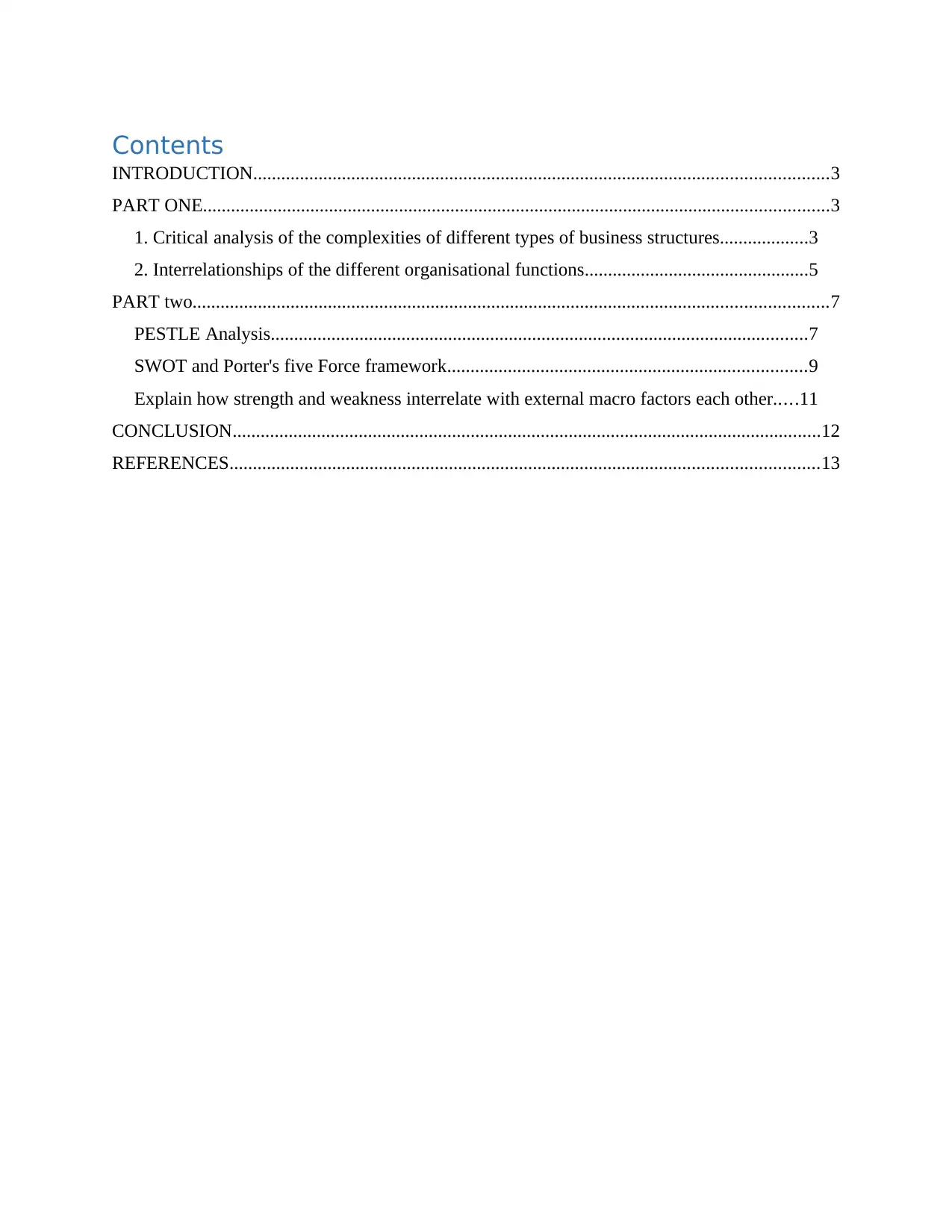
Contents
INTRODUCTION...........................................................................................................................3
PART ONE......................................................................................................................................3
1. Critical analysis of the complexities of different types of business structures...................3
2. Interrelationships of the different organisational functions................................................5
PART two........................................................................................................................................7
PESTLE Analysis...................................................................................................................7
SWOT and Porter's five Force framework.............................................................................9
Explain how strength and weakness interrelate with external macro factors each other.....11
CONCLUSION..............................................................................................................................12
REFERENCES..............................................................................................................................13
INTRODUCTION...........................................................................................................................3
PART ONE......................................................................................................................................3
1. Critical analysis of the complexities of different types of business structures...................3
2. Interrelationships of the different organisational functions................................................5
PART two........................................................................................................................................7
PESTLE Analysis...................................................................................................................7
SWOT and Porter's five Force framework.............................................................................9
Explain how strength and weakness interrelate with external macro factors each other.....11
CONCLUSION..............................................................................................................................12
REFERENCES..............................................................................................................................13
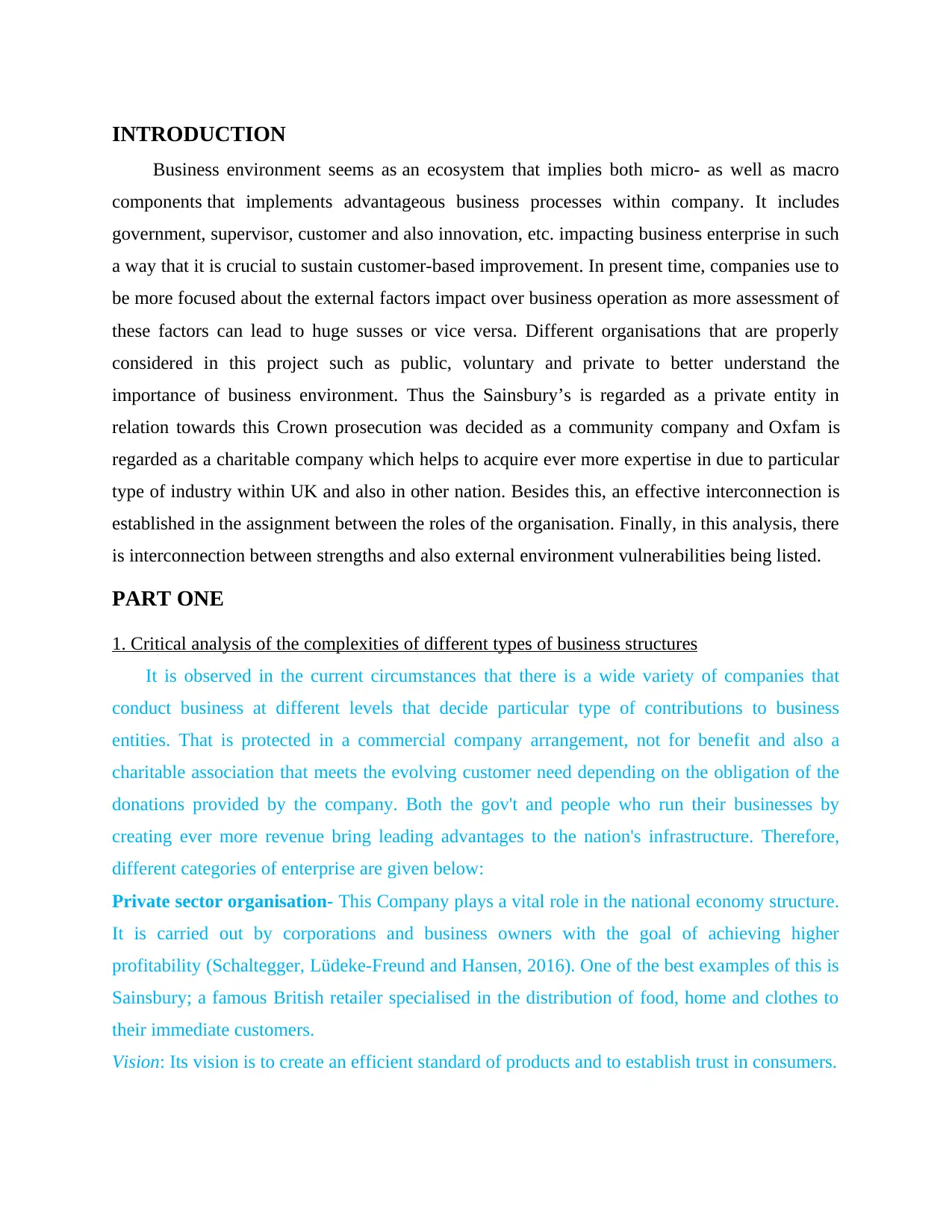
INTRODUCTION
Business environment seems as an ecosystem that implies both micro- as well as macro
components that implements advantageous business processes within company. It includes
government, supervisor, customer and also innovation, etc. impacting business enterprise in such
a way that it is crucial to sustain customer-based improvement. In present time, companies use to
be more focused about the external factors impact over business operation as more assessment of
these factors can lead to huge susses or vice versa. Different organisations that are properly
considered in this project such as public, voluntary and private to better understand the
importance of business environment. Thus the Sainsbury’s is regarded as a private entity in
relation towards this Crown prosecution was decided as a community company and Oxfam is
regarded as a charitable company which helps to acquire ever more expertise in due to particular
type of industry within UK and also in other nation. Besides this, an effective interconnection is
established in the assignment between the roles of the organisation. Finally, in this analysis, there
is interconnection between strengths and also external environment vulnerabilities being listed.
PART ONE
1. Critical analysis of the complexities of different types of business structures
It is observed in the current circumstances that there is a wide variety of companies that
conduct business at different levels that decide particular type of contributions to business
entities. That is protected in a commercial company arrangement, not for benefit and also a
charitable association that meets the evolving customer need depending on the obligation of the
donations provided by the company. Both the gov't and people who run their businesses by
creating ever more revenue bring leading advantages to the nation's infrastructure. Therefore,
different categories of enterprise are given below:
Private sector organisation- This Company plays a vital role in the national economy structure.
It is carried out by corporations and business owners with the goal of achieving higher
profitability (Schaltegger, Lüdeke-Freund and Hansen, 2016). One of the best examples of this is
Sainsbury; a famous British retailer specialised in the distribution of food, home and clothes to
their immediate customers.
Vision: Its vision is to create an efficient standard of products and to establish trust in consumers.
Business environment seems as an ecosystem that implies both micro- as well as macro
components that implements advantageous business processes within company. It includes
government, supervisor, customer and also innovation, etc. impacting business enterprise in such
a way that it is crucial to sustain customer-based improvement. In present time, companies use to
be more focused about the external factors impact over business operation as more assessment of
these factors can lead to huge susses or vice versa. Different organisations that are properly
considered in this project such as public, voluntary and private to better understand the
importance of business environment. Thus the Sainsbury’s is regarded as a private entity in
relation towards this Crown prosecution was decided as a community company and Oxfam is
regarded as a charitable company which helps to acquire ever more expertise in due to particular
type of industry within UK and also in other nation. Besides this, an effective interconnection is
established in the assignment between the roles of the organisation. Finally, in this analysis, there
is interconnection between strengths and also external environment vulnerabilities being listed.
PART ONE
1. Critical analysis of the complexities of different types of business structures
It is observed in the current circumstances that there is a wide variety of companies that
conduct business at different levels that decide particular type of contributions to business
entities. That is protected in a commercial company arrangement, not for benefit and also a
charitable association that meets the evolving customer need depending on the obligation of the
donations provided by the company. Both the gov't and people who run their businesses by
creating ever more revenue bring leading advantages to the nation's infrastructure. Therefore,
different categories of enterprise are given below:
Private sector organisation- This Company plays a vital role in the national economy structure.
It is carried out by corporations and business owners with the goal of achieving higher
profitability (Schaltegger, Lüdeke-Freund and Hansen, 2016). One of the best examples of this is
Sainsbury; a famous British retailer specialised in the distribution of food, home and clothes to
their immediate customers.
Vision: Its vision is to create an efficient standard of products and to establish trust in consumers.
⊘ This is a preview!⊘
Do you want full access?
Subscribe today to unlock all pages.

Trusted by 1+ million students worldwide

Mission: Its goal is to create aspiring quality products that are readily available to everyone, both
deep and large in the variety of their items.
Objectives: Its aim is to establish a standard for others based on the quality of their products and
services. This includes ore worth as imagination, consistency and the like.
Types of Public sector organisation
Sole proprietorship: When an undertaking is handled by an individual, it is perceived
to be a sole proprietor where the owner of the undertaking tends to bear the profits as
well as the costs themselves. It is both conventional as well as the easiest way of
running the company. Along with this, there are fewer limitations and they can be
quickly dissolved.
Partnership: Where more than two individuals operate in a consistent set with the
intention of earning the anticipated benefit as well as growth, they are considered to
be partnerships. These forms are allowed by entering into a partnership arrangement
that contains approved specifics of the participant, capital progression, benefit sharing
and others.
Joint venture: Joint stock firms are those with small capital means, but this pushes
them to a massive risk pressure. It also creates a kind of venture capital through the
selling of challenging shares.
Purpose: Its main goal as a private company is to achieve sustainability as well as to be a pioneer
in their respective sectors. The goal of Sainsbury is also to deliver quality products and services
to their prospective audiences in order to achieve a pre-defined viability and survival of the
company.
Legal structure: Sainsbury adhere with the public restricted regulatory system and have a wide
range of active companies offering high-quality services to their potential clients.
Public sector organisation- This entity is a business that is generally governed by the
government of the particular nations for the delivery of goods and services and also for the
benefit of society. The National Health Service (NHS) is the best type of public sector agency by
offering healthcare coverage to residents of the whole area on the basis of health care needs
instead of determining their payment ability.
deep and large in the variety of their items.
Objectives: Its aim is to establish a standard for others based on the quality of their products and
services. This includes ore worth as imagination, consistency and the like.
Types of Public sector organisation
Sole proprietorship: When an undertaking is handled by an individual, it is perceived
to be a sole proprietor where the owner of the undertaking tends to bear the profits as
well as the costs themselves. It is both conventional as well as the easiest way of
running the company. Along with this, there are fewer limitations and they can be
quickly dissolved.
Partnership: Where more than two individuals operate in a consistent set with the
intention of earning the anticipated benefit as well as growth, they are considered to
be partnerships. These forms are allowed by entering into a partnership arrangement
that contains approved specifics of the participant, capital progression, benefit sharing
and others.
Joint venture: Joint stock firms are those with small capital means, but this pushes
them to a massive risk pressure. It also creates a kind of venture capital through the
selling of challenging shares.
Purpose: Its main goal as a private company is to achieve sustainability as well as to be a pioneer
in their respective sectors. The goal of Sainsbury is also to deliver quality products and services
to their prospective audiences in order to achieve a pre-defined viability and survival of the
company.
Legal structure: Sainsbury adhere with the public restricted regulatory system and have a wide
range of active companies offering high-quality services to their potential clients.
Public sector organisation- This entity is a business that is generally governed by the
government of the particular nations for the delivery of goods and services and also for the
benefit of society. The National Health Service (NHS) is the best type of public sector agency by
offering healthcare coverage to residents of the whole area on the basis of health care needs
instead of determining their payment ability.
Paraphrase This Document
Need a fresh take? Get an instant paraphrase of this document with our AI Paraphraser
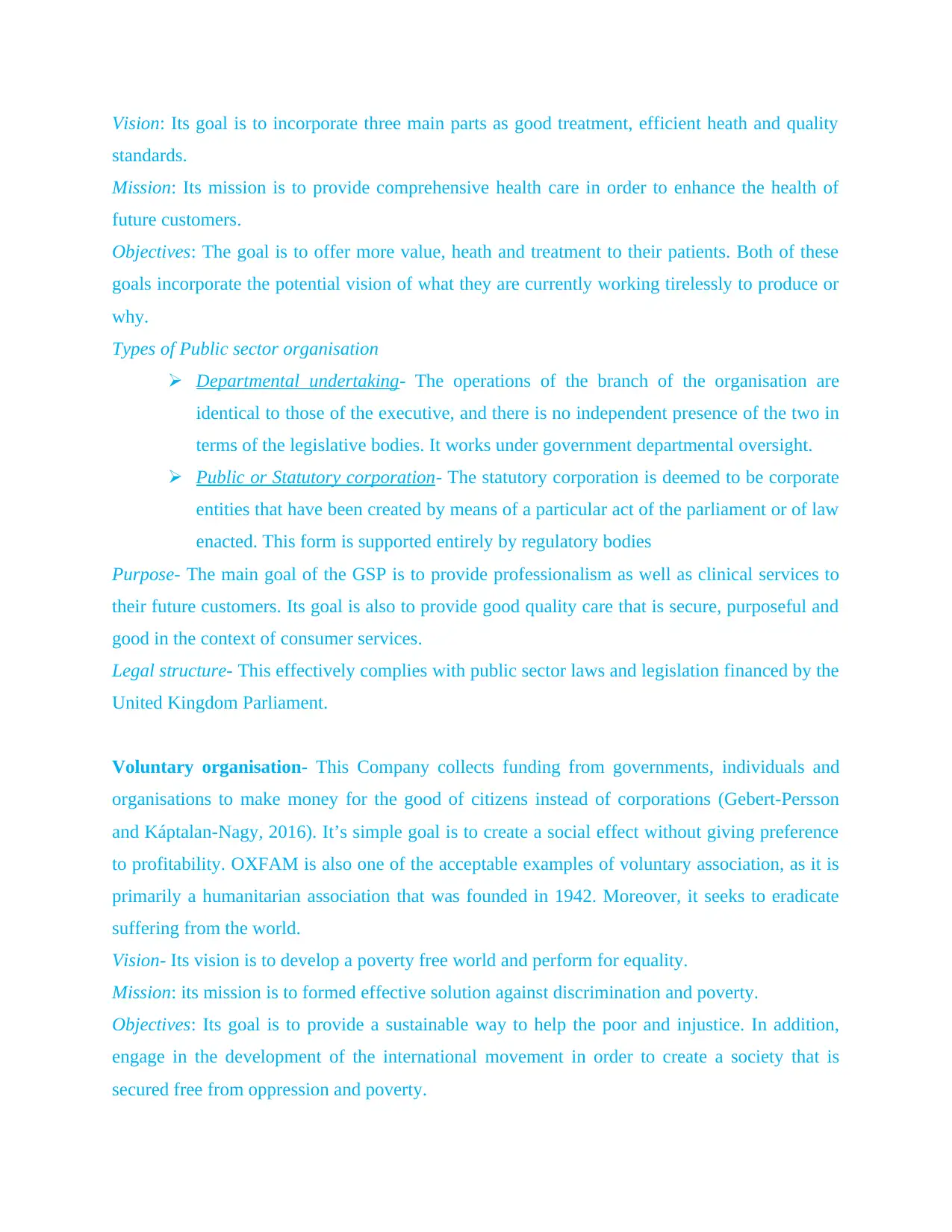
Vision: Its goal is to incorporate three main parts as good treatment, efficient heath and quality
standards.
Mission: Its mission is to provide comprehensive health care in order to enhance the health of
future customers.
Objectives: The goal is to offer more value, heath and treatment to their patients. Both of these
goals incorporate the potential vision of what they are currently working tirelessly to produce or
why.
Types of Public sector organisation
Departmental undertaking- The operations of the branch of the organisation are
identical to those of the executive, and there is no independent presence of the two in
terms of the legislative bodies. It works under government departmental oversight.
Public or Statutory corporation- The statutory corporation is deemed to be corporate
entities that have been created by means of a particular act of the parliament or of law
enacted. This form is supported entirely by regulatory bodies
Purpose- The main goal of the GSP is to provide professionalism as well as clinical services to
their future customers. Its goal is also to provide good quality care that is secure, purposeful and
good in the context of consumer services.
Legal structure- This effectively complies with public sector laws and legislation financed by the
United Kingdom Parliament.
Voluntary organisation- This Company collects funding from governments, individuals and
organisations to make money for the good of citizens instead of corporations (Gebert-Persson
and Káptalan-Nagy, 2016). It’s simple goal is to create a social effect without giving preference
to profitability. OXFAM is also one of the acceptable examples of voluntary association, as it is
primarily a humanitarian association that was founded in 1942. Moreover, it seeks to eradicate
suffering from the world.
Vision- Its vision is to develop a poverty free world and perform for equality.
Mission: its mission is to formed effective solution against discrimination and poverty.
Objectives: Its goal is to provide a sustainable way to help the poor and injustice. In addition,
engage in the development of the international movement in order to create a society that is
secured free from oppression and poverty.
standards.
Mission: Its mission is to provide comprehensive health care in order to enhance the health of
future customers.
Objectives: The goal is to offer more value, heath and treatment to their patients. Both of these
goals incorporate the potential vision of what they are currently working tirelessly to produce or
why.
Types of Public sector organisation
Departmental undertaking- The operations of the branch of the organisation are
identical to those of the executive, and there is no independent presence of the two in
terms of the legislative bodies. It works under government departmental oversight.
Public or Statutory corporation- The statutory corporation is deemed to be corporate
entities that have been created by means of a particular act of the parliament or of law
enacted. This form is supported entirely by regulatory bodies
Purpose- The main goal of the GSP is to provide professionalism as well as clinical services to
their future customers. Its goal is also to provide good quality care that is secure, purposeful and
good in the context of consumer services.
Legal structure- This effectively complies with public sector laws and legislation financed by the
United Kingdom Parliament.
Voluntary organisation- This Company collects funding from governments, individuals and
organisations to make money for the good of citizens instead of corporations (Gebert-Persson
and Káptalan-Nagy, 2016). It’s simple goal is to create a social effect without giving preference
to profitability. OXFAM is also one of the acceptable examples of voluntary association, as it is
primarily a humanitarian association that was founded in 1942. Moreover, it seeks to eradicate
suffering from the world.
Vision- Its vision is to develop a poverty free world and perform for equality.
Mission: its mission is to formed effective solution against discrimination and poverty.
Objectives: Its goal is to provide a sustainable way to help the poor and injustice. In addition,
engage in the development of the international movement in order to create a society that is
secured free from oppression and poverty.
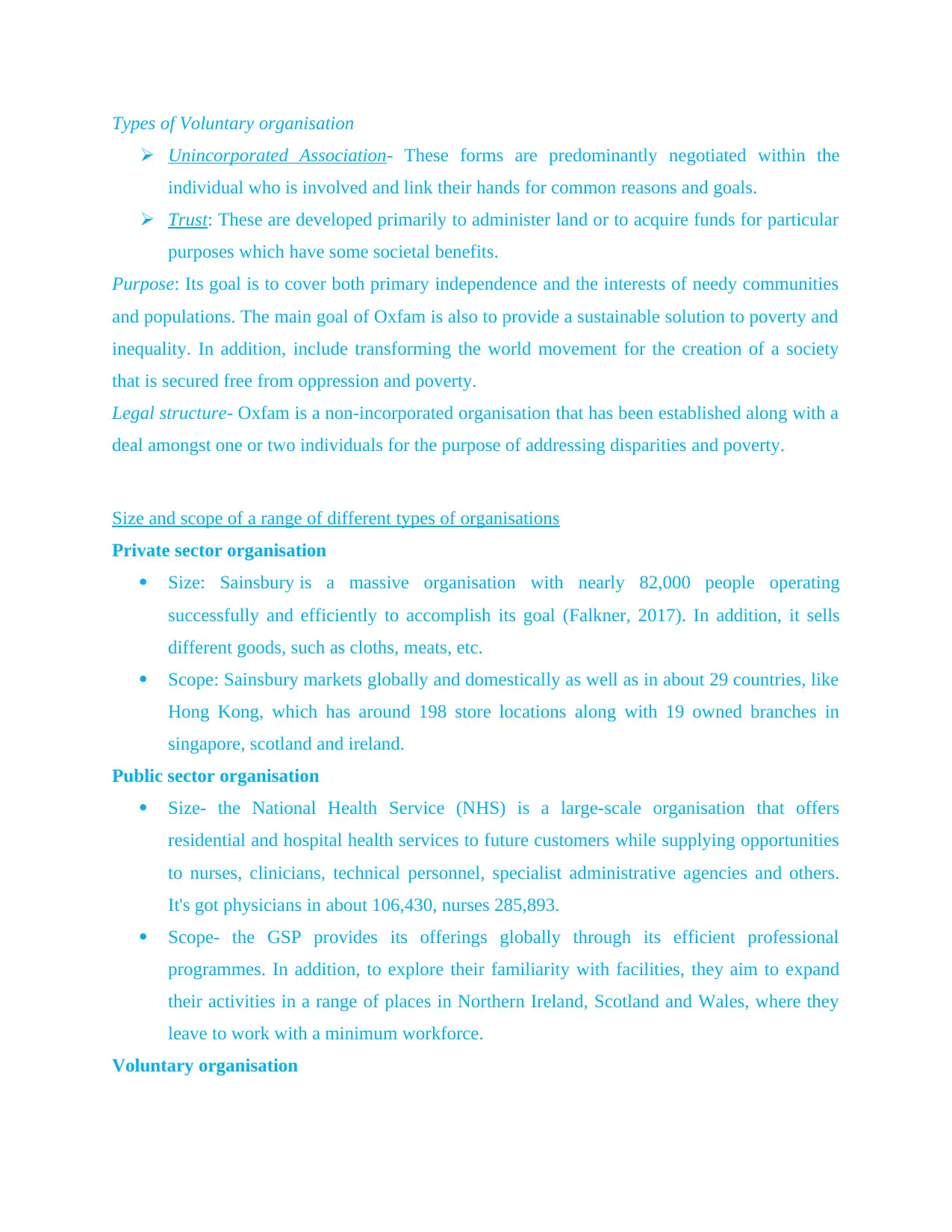
Types of Voluntary organisation
Unincorporated Association- These forms are predominantly negotiated within the
individual who is involved and link their hands for common reasons and goals.
Trust: These are developed primarily to administer land or to acquire funds for particular
purposes which have some societal benefits.
Purpose: Its goal is to cover both primary independence and the interests of needy communities
and populations. The main goal of Oxfam is also to provide a sustainable solution to poverty and
inequality. In addition, include transforming the world movement for the creation of a society
that is secured free from oppression and poverty.
Legal structure- Oxfam is a non-incorporated organisation that has been established along with a
deal amongst one or two individuals for the purpose of addressing disparities and poverty.
Size and scope of a range of different types of organisations
Private sector organisation
Size: Sainsbury is a massive organisation with nearly 82,000 people operating
successfully and efficiently to accomplish its goal (Falkner, 2017). In addition, it sells
different goods, such as cloths, meats, etc.
Scope: Sainsbury markets globally and domestically as well as in about 29 countries, like
Hong Kong, which has around 198 store locations along with 19 owned branches in
singapore, scotland and ireland.
Public sector organisation
Size- the National Health Service (NHS) is a large-scale organisation that offers
residential and hospital health services to future customers while supplying opportunities
to nurses, clinicians, technical personnel, specialist administrative agencies and others.
It's got physicians in about 106,430, nurses 285,893.
Scope- the GSP provides its offerings globally through its efficient professional
programmes. In addition, to explore their familiarity with facilities, they aim to expand
their activities in a range of places in Northern Ireland, Scotland and Wales, where they
leave to work with a minimum workforce.
Voluntary organisation
Unincorporated Association- These forms are predominantly negotiated within the
individual who is involved and link their hands for common reasons and goals.
Trust: These are developed primarily to administer land or to acquire funds for particular
purposes which have some societal benefits.
Purpose: Its goal is to cover both primary independence and the interests of needy communities
and populations. The main goal of Oxfam is also to provide a sustainable solution to poverty and
inequality. In addition, include transforming the world movement for the creation of a society
that is secured free from oppression and poverty.
Legal structure- Oxfam is a non-incorporated organisation that has been established along with a
deal amongst one or two individuals for the purpose of addressing disparities and poverty.
Size and scope of a range of different types of organisations
Private sector organisation
Size: Sainsbury is a massive organisation with nearly 82,000 people operating
successfully and efficiently to accomplish its goal (Falkner, 2017). In addition, it sells
different goods, such as cloths, meats, etc.
Scope: Sainsbury markets globally and domestically as well as in about 29 countries, like
Hong Kong, which has around 198 store locations along with 19 owned branches in
singapore, scotland and ireland.
Public sector organisation
Size- the National Health Service (NHS) is a large-scale organisation that offers
residential and hospital health services to future customers while supplying opportunities
to nurses, clinicians, technical personnel, specialist administrative agencies and others.
It's got physicians in about 106,430, nurses 285,893.
Scope- the GSP provides its offerings globally through its efficient professional
programmes. In addition, to explore their familiarity with facilities, they aim to expand
their activities in a range of places in Northern Ireland, Scotland and Wales, where they
leave to work with a minimum workforce.
Voluntary organisation
⊘ This is a preview!⊘
Do you want full access?
Subscribe today to unlock all pages.

Trusted by 1+ million students worldwide
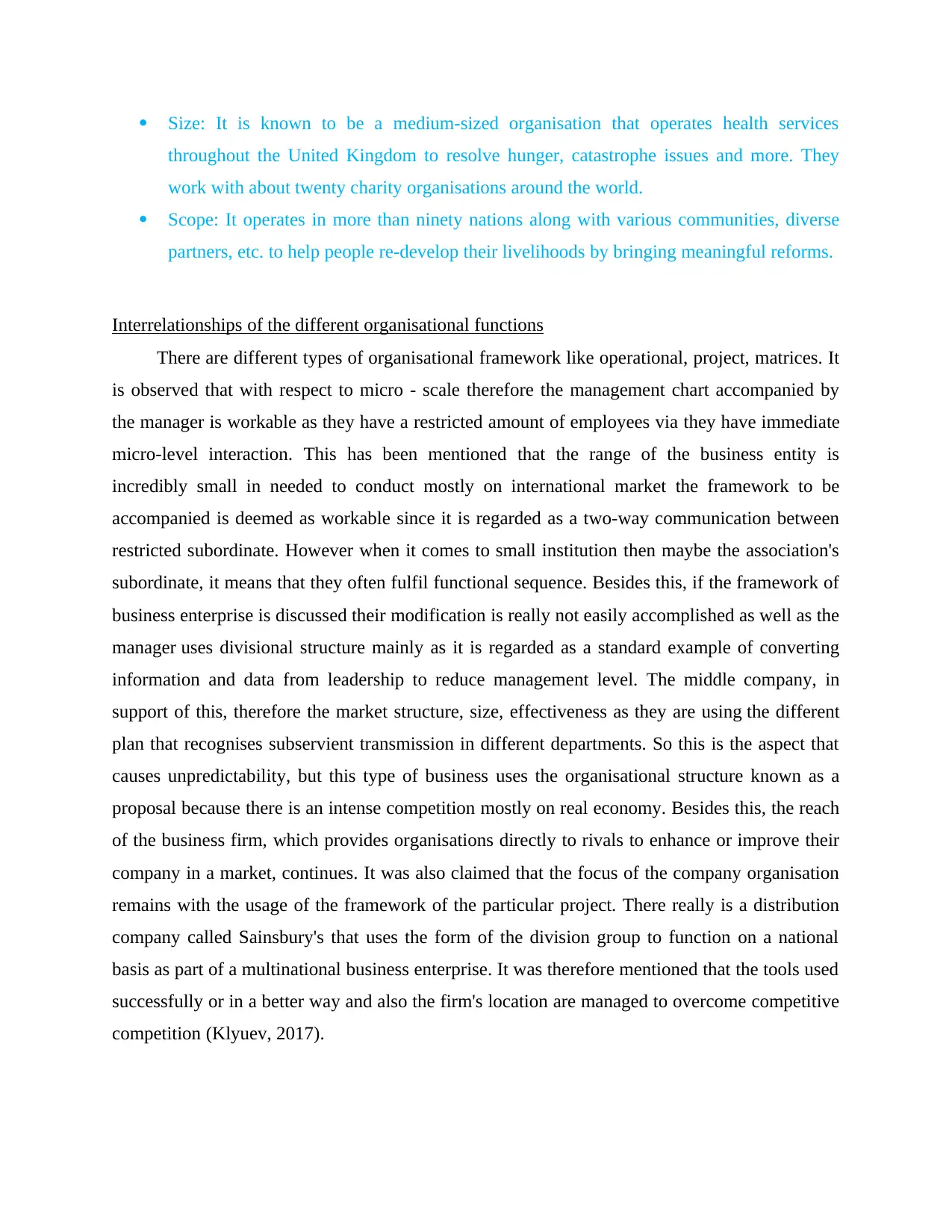
Size: It is known to be a medium-sized organisation that operates health services
throughout the United Kingdom to resolve hunger, catastrophe issues and more. They
work with about twenty charity organisations around the world.
Scope: It operates in more than ninety nations along with various communities, diverse
partners, etc. to help people re-develop their livelihoods by bringing meaningful reforms.
Interrelationships of the different organisational functions
There are different types of organisational framework like operational, project, matrices. It
is observed that with respect to micro - scale therefore the management chart accompanied by
the manager is workable as they have a restricted amount of employees via they have immediate
micro-level interaction. This has been mentioned that the range of the business entity is
incredibly small in needed to conduct mostly on international market the framework to be
accompanied is deemed as workable since it is regarded as a two-way communication between
restricted subordinate. However when it comes to small institution then maybe the association's
subordinate, it means that they often fulfil functional sequence. Besides this, if the framework of
business enterprise is discussed their modification is really not easily accomplished as well as the
manager uses divisional structure mainly as it is regarded as a standard example of converting
information and data from leadership to reduce management level. The middle company, in
support of this, therefore the market structure, size, effectiveness as they are using the different
plan that recognises subservient transmission in different departments. So this is the aspect that
causes unpredictability, but this type of business uses the organisational structure known as a
proposal because there is an intense competition mostly on real economy. Besides this, the reach
of the business firm, which provides organisations directly to rivals to enhance or improve their
company in a market, continues. It was also claimed that the focus of the company organisation
remains with the usage of the framework of the particular project. There really is a distribution
company called Sainsbury's that uses the form of the division group to function on a national
basis as part of a multinational business enterprise. It was therefore mentioned that the tools used
successfully or in a better way and also the firm's location are managed to overcome competitive
competition (Klyuev, 2017).
throughout the United Kingdom to resolve hunger, catastrophe issues and more. They
work with about twenty charity organisations around the world.
Scope: It operates in more than ninety nations along with various communities, diverse
partners, etc. to help people re-develop their livelihoods by bringing meaningful reforms.
Interrelationships of the different organisational functions
There are different types of organisational framework like operational, project, matrices. It
is observed that with respect to micro - scale therefore the management chart accompanied by
the manager is workable as they have a restricted amount of employees via they have immediate
micro-level interaction. This has been mentioned that the range of the business entity is
incredibly small in needed to conduct mostly on international market the framework to be
accompanied is deemed as workable since it is regarded as a two-way communication between
restricted subordinate. However when it comes to small institution then maybe the association's
subordinate, it means that they often fulfil functional sequence. Besides this, if the framework of
business enterprise is discussed their modification is really not easily accomplished as well as the
manager uses divisional structure mainly as it is regarded as a standard example of converting
information and data from leadership to reduce management level. The middle company, in
support of this, therefore the market structure, size, effectiveness as they are using the different
plan that recognises subservient transmission in different departments. So this is the aspect that
causes unpredictability, but this type of business uses the organisational structure known as a
proposal because there is an intense competition mostly on real economy. Besides this, the reach
of the business firm, which provides organisations directly to rivals to enhance or improve their
company in a market, continues. It was also claimed that the focus of the company organisation
remains with the usage of the framework of the particular project. There really is a distribution
company called Sainsbury's that uses the form of the division group to function on a national
basis as part of a multinational business enterprise. It was therefore mentioned that the tools used
successfully or in a better way and also the firm's location are managed to overcome competitive
competition (Klyuev, 2017).
Paraphrase This Document
Need a fresh take? Get an instant paraphrase of this document with our AI Paraphraser

This has been mentioned that the complexities with respect to the arrangement of the
Global Organization indicate the confusion while also being important for organisations like
changing them as appropriate. Besides this there are separate areas for better execution of
different activities. The department of manufacturing, distribution, advertising as well as HR for
different or related sectors introduced by Sainsbury’s higher-level jurisdiction and members
are divided according to their expertise and dedication. It helps in handling employees or
employees to provide its clients with relevant goods and services.
HR department's duty to treat applicants with appropriate subordinates to coordinate
numerous tasks such as recruiting, nominating, reimbursing and having healthy relationships
with their staff and performing successful training sessions carried out by Sainsbury's
management team. It helps move the delegate to other divisions where it is marketing,
advertising and finance. Therefore the superior is interested in building competitive advantage
and meeting individual customers desires or need.
It's really the duty of the R&d team to arrange surveys and obtain even more knowledge
about the desires and expectations of the market and its innovative business. It is the
responsibility or essential for company, similar to the need of the particular person, to deliver the
goods and services. Sainsbury's is seen as a retailer wherein the R&D department is focused on
conducting successful analysis to acquire far more information about consumer dynamics. It
helps to offer new goods and services to draw end customers (Yang, 2017).
Marketing team plays a significant role, focused on delivering product-related details
about company products to the customer and their facilities. Effective marketing strategy should
be drawn up in which campaign mix, expenditure, target population and other details or facts are
Global Organization indicate the confusion while also being important for organisations like
changing them as appropriate. Besides this there are separate areas for better execution of
different activities. The department of manufacturing, distribution, advertising as well as HR for
different or related sectors introduced by Sainsbury’s higher-level jurisdiction and members
are divided according to their expertise and dedication. It helps in handling employees or
employees to provide its clients with relevant goods and services.
HR department's duty to treat applicants with appropriate subordinates to coordinate
numerous tasks such as recruiting, nominating, reimbursing and having healthy relationships
with their staff and performing successful training sessions carried out by Sainsbury's
management team. It helps move the delegate to other divisions where it is marketing,
advertising and finance. Therefore the superior is interested in building competitive advantage
and meeting individual customers desires or need.
It's really the duty of the R&d team to arrange surveys and obtain even more knowledge
about the desires and expectations of the market and its innovative business. It is the
responsibility or essential for company, similar to the need of the particular person, to deliver the
goods and services. Sainsbury's is seen as a retailer wherein the R&D department is focused on
conducting successful analysis to acquire far more information about consumer dynamics. It
helps to offer new goods and services to draw end customers (Yang, 2017).
Marketing team plays a significant role, focused on delivering product-related details
about company products to the customer and their facilities. Effective marketing strategy should
be drawn up in which campaign mix, expenditure, target population and other details or facts are
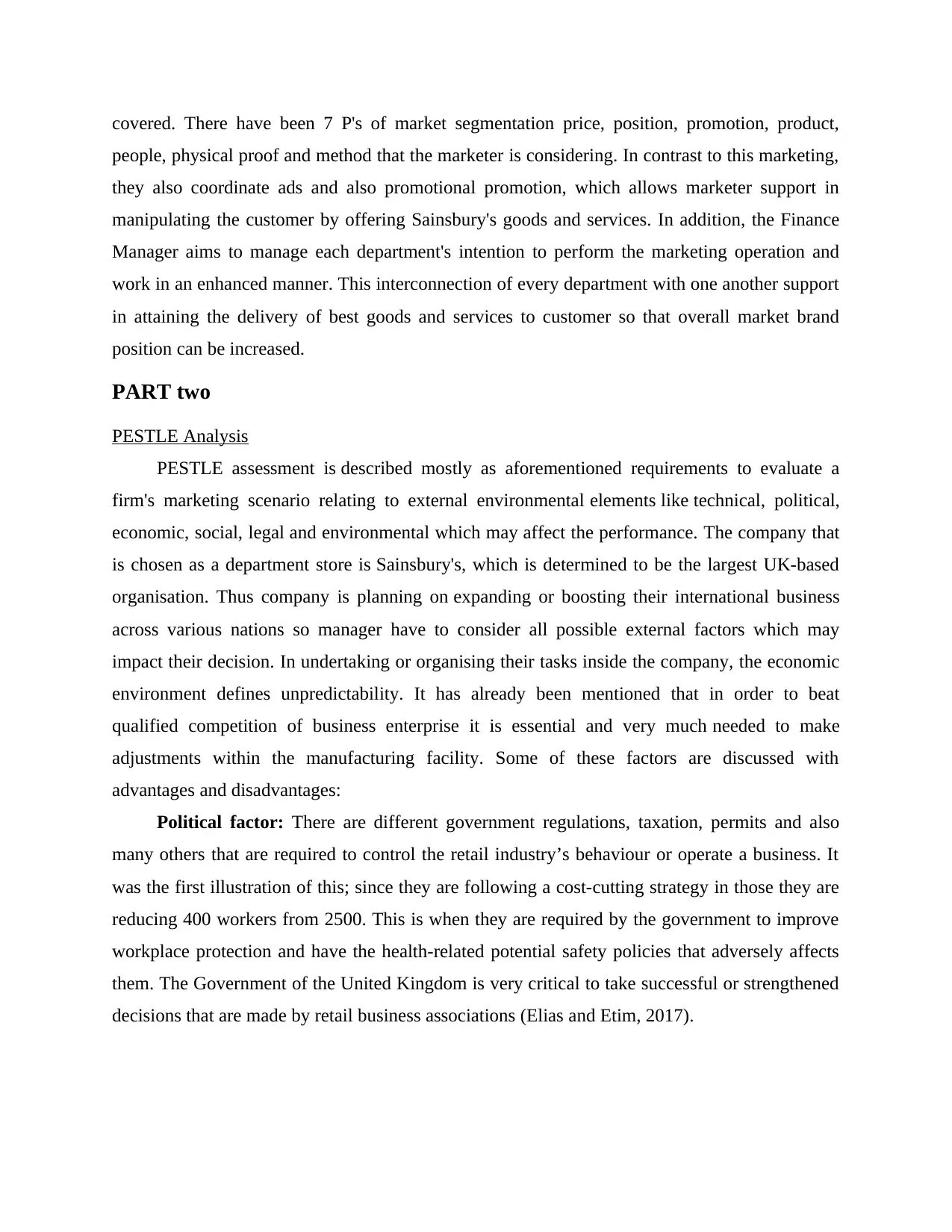
covered. There have been 7 P's of market segmentation price, position, promotion, product,
people, physical proof and method that the marketer is considering. In contrast to this marketing,
they also coordinate ads and also promotional promotion, which allows marketer support in
manipulating the customer by offering Sainsbury's goods and services. In addition, the Finance
Manager aims to manage each department's intention to perform the marketing operation and
work in an enhanced manner. This interconnection of every department with one another support
in attaining the delivery of best goods and services to customer so that overall market brand
position can be increased.
PART two
PESTLE Analysis
PESTLE assessment is described mostly as aforementioned requirements to evaluate a
firm's marketing scenario relating to external environmental elements like technical, political,
economic, social, legal and environmental which may affect the performance. The company that
is chosen as a department store is Sainsbury's, which is determined to be the largest UK-based
organisation. Thus company is planning on expanding or boosting their international business
across various nations so manager have to consider all possible external factors which may
impact their decision. In undertaking or organising their tasks inside the company, the economic
environment defines unpredictability. It has already been mentioned that in order to beat
qualified competition of business enterprise it is essential and very much needed to make
adjustments within the manufacturing facility. Some of these factors are discussed with
advantages and disadvantages:
Political factor: There are different government regulations, taxation, permits and also
many others that are required to control the retail industry’s behaviour or operate a business. It
was the first illustration of this; since they are following a cost-cutting strategy in those they are
reducing 400 workers from 2500. This is when they are required by the government to improve
workplace protection and have the health-related potential safety policies that adversely affects
them. The Government of the United Kingdom is very critical to take successful or strengthened
decisions that are made by retail business associations (Elias and Etim, 2017).
people, physical proof and method that the marketer is considering. In contrast to this marketing,
they also coordinate ads and also promotional promotion, which allows marketer support in
manipulating the customer by offering Sainsbury's goods and services. In addition, the Finance
Manager aims to manage each department's intention to perform the marketing operation and
work in an enhanced manner. This interconnection of every department with one another support
in attaining the delivery of best goods and services to customer so that overall market brand
position can be increased.
PART two
PESTLE Analysis
PESTLE assessment is described mostly as aforementioned requirements to evaluate a
firm's marketing scenario relating to external environmental elements like technical, political,
economic, social, legal and environmental which may affect the performance. The company that
is chosen as a department store is Sainsbury's, which is determined to be the largest UK-based
organisation. Thus company is planning on expanding or boosting their international business
across various nations so manager have to consider all possible external factors which may
impact their decision. In undertaking or organising their tasks inside the company, the economic
environment defines unpredictability. It has already been mentioned that in order to beat
qualified competition of business enterprise it is essential and very much needed to make
adjustments within the manufacturing facility. Some of these factors are discussed with
advantages and disadvantages:
Political factor: There are different government regulations, taxation, permits and also
many others that are required to control the retail industry’s behaviour or operate a business. It
was the first illustration of this; since they are following a cost-cutting strategy in those they are
reducing 400 workers from 2500. This is when they are required by the government to improve
workplace protection and have the health-related potential safety policies that adversely affects
them. The Government of the United Kingdom is very critical to take successful or strengthened
decisions that are made by retail business associations (Elias and Etim, 2017).
⊘ This is a preview!⊘
Do you want full access?
Subscribe today to unlock all pages.

Trusted by 1+ million students worldwide
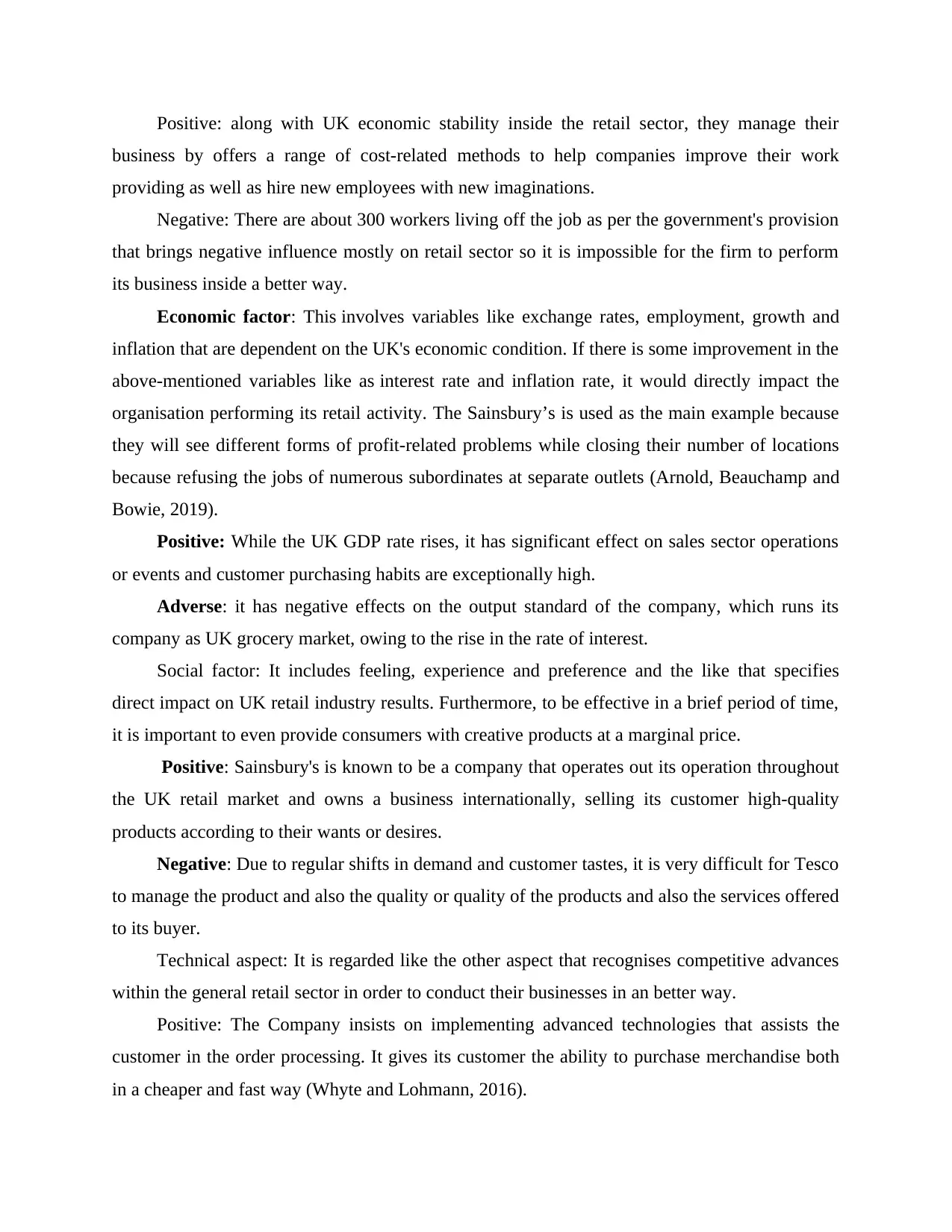
Positive: along with UK economic stability inside the retail sector, they manage their
business by offers a range of cost-related methods to help companies improve their work
providing as well as hire new employees with new imaginations.
Negative: There are about 300 workers living off the job as per the government's provision
that brings negative influence mostly on retail sector so it is impossible for the firm to perform
its business inside a better way.
Economic factor: This involves variables like exchange rates, employment, growth and
inflation that are dependent on the UK's economic condition. If there is some improvement in the
above-mentioned variables like as interest rate and inflation rate, it would directly impact the
organisation performing its retail activity. The Sainsbury’s is used as the main example because
they will see different forms of profit-related problems while closing their number of locations
because refusing the jobs of numerous subordinates at separate outlets (Arnold, Beauchamp and
Bowie, 2019).
Positive: While the UK GDP rate rises, it has significant effect on sales sector operations
or events and customer purchasing habits are exceptionally high.
Adverse: it has negative effects on the output standard of the company, which runs its
company as UK grocery market, owing to the rise in the rate of interest.
Social factor: It includes feeling, experience and preference and the like that specifies
direct impact on UK retail industry results. Furthermore, to be effective in a brief period of time,
it is important to even provide consumers with creative products at a marginal price.
Positive: Sainsbury's is known to be a company that operates out its operation throughout
the UK retail market and owns a business internationally, selling its customer high-quality
products according to their wants or desires.
Negative: Due to regular shifts in demand and customer tastes, it is very difficult for Tesco
to manage the product and also the quality or quality of the products and also the services offered
to its buyer.
Technical aspect: It is regarded like the other aspect that recognises competitive advances
within the general retail sector in order to conduct their businesses in an better way.
Positive: The Company insists on implementing advanced technologies that assists the
customer in the order processing. It gives its customer the ability to purchase merchandise both
in a cheaper and fast way (Whyte and Lohmann, 2016).
business by offers a range of cost-related methods to help companies improve their work
providing as well as hire new employees with new imaginations.
Negative: There are about 300 workers living off the job as per the government's provision
that brings negative influence mostly on retail sector so it is impossible for the firm to perform
its business inside a better way.
Economic factor: This involves variables like exchange rates, employment, growth and
inflation that are dependent on the UK's economic condition. If there is some improvement in the
above-mentioned variables like as interest rate and inflation rate, it would directly impact the
organisation performing its retail activity. The Sainsbury’s is used as the main example because
they will see different forms of profit-related problems while closing their number of locations
because refusing the jobs of numerous subordinates at separate outlets (Arnold, Beauchamp and
Bowie, 2019).
Positive: While the UK GDP rate rises, it has significant effect on sales sector operations
or events and customer purchasing habits are exceptionally high.
Adverse: it has negative effects on the output standard of the company, which runs its
company as UK grocery market, owing to the rise in the rate of interest.
Social factor: It includes feeling, experience and preference and the like that specifies
direct impact on UK retail industry results. Furthermore, to be effective in a brief period of time,
it is important to even provide consumers with creative products at a marginal price.
Positive: Sainsbury's is known to be a company that operates out its operation throughout
the UK retail market and owns a business internationally, selling its customer high-quality
products according to their wants or desires.
Negative: Due to regular shifts in demand and customer tastes, it is very difficult for Tesco
to manage the product and also the quality or quality of the products and also the services offered
to its buyer.
Technical aspect: It is regarded like the other aspect that recognises competitive advances
within the general retail sector in order to conduct their businesses in an better way.
Positive: The Company insists on implementing advanced technologies that assists the
customer in the order processing. It gives its customer the ability to purchase merchandise both
in a cheaper and fast way (Whyte and Lohmann, 2016).
Paraphrase This Document
Need a fresh take? Get an instant paraphrase of this document with our AI Paraphraser

Negative: There are various kinds of subordinates here who may not have the experience
of advanced technologies that has detrimental effects on the quality of output on Retail Business,
and workers become unemployed throughout the short amount of time.
Legitimate factor: This element is protected by regulations and also legislation imposed by
the state, key actions to the retail business and also having a direct and indirect impact in almost
the same period.
Positive: It has great effect on Sainsbury's because of Brexit and gives the chance to
increase the profit margin.
Negative: Numerous activities that even the government is taking due to Brexit such that
the job arrives resigning from the job which negatively impacts the grocery store chain.
Environmental Factor: The other component of the pollution-related external issue and also
the clean environment that the organisation aims at providing best goods or services that
significantly raise the people's living standards throughout the society that positively affects the
business. At other side, due to increased pollution, it has a negative impact on a Sainsbury’s
functioning as customer will prefer to buy goods that are least harmful for the environment.
SWOT and Porter's five Force framework
SWOT Analysis
SWOT is a method designed to identify weaknesses, opportunities, threats and strengths.
The consequence of this appraisal signifies real economy-place rivalry, which is intensified by
better tactics and strategy (Trad and Kalpić, 2017).
Strengths: Sainsbury's regarded to be a well-established brand that covers the area about
30%, approximately 6800 channels in about 14 nations. This is considered to be the
organization's corporate benefit in order to improve and develop their company in a number of
products in various shops like non-food items. It was also reported that it will be recognised as a
work creator that has created the worldwide jobs of 743000. Besides this, developed technology
is adopted in beneficial effects which raises the rate of shopping perspective of different users
but also launches RFID designed to quickly make accurate checking of the purchasing items.
Weakness: In order to have access to the intensity, there have been some
Sainsbury's weaknesses like starting their operations on the Japanese market and not surviving at
the global market. They will not be able to distribute the products they need on the international
economy. They had already prosecuted large amounts of punishments or penalty for ridiculous
of advanced technologies that has detrimental effects on the quality of output on Retail Business,
and workers become unemployed throughout the short amount of time.
Legitimate factor: This element is protected by regulations and also legislation imposed by
the state, key actions to the retail business and also having a direct and indirect impact in almost
the same period.
Positive: It has great effect on Sainsbury's because of Brexit and gives the chance to
increase the profit margin.
Negative: Numerous activities that even the government is taking due to Brexit such that
the job arrives resigning from the job which negatively impacts the grocery store chain.
Environmental Factor: The other component of the pollution-related external issue and also
the clean environment that the organisation aims at providing best goods or services that
significantly raise the people's living standards throughout the society that positively affects the
business. At other side, due to increased pollution, it has a negative impact on a Sainsbury’s
functioning as customer will prefer to buy goods that are least harmful for the environment.
SWOT and Porter's five Force framework
SWOT Analysis
SWOT is a method designed to identify weaknesses, opportunities, threats and strengths.
The consequence of this appraisal signifies real economy-place rivalry, which is intensified by
better tactics and strategy (Trad and Kalpić, 2017).
Strengths: Sainsbury's regarded to be a well-established brand that covers the area about
30%, approximately 6800 channels in about 14 nations. This is considered to be the
organization's corporate benefit in order to improve and develop their company in a number of
products in various shops like non-food items. It was also reported that it will be recognised as a
work creator that has created the worldwide jobs of 743000. Besides this, developed technology
is adopted in beneficial effects which raises the rate of shopping perspective of different users
but also launches RFID designed to quickly make accurate checking of the purchasing items.
Weakness: In order to have access to the intensity, there have been some
Sainsbury's weaknesses like starting their operations on the Japanese market and not surviving at
the global market. They will not be able to distribute the products they need on the international
economy. They had already prosecuted large amounts of punishments or penalty for ridiculous
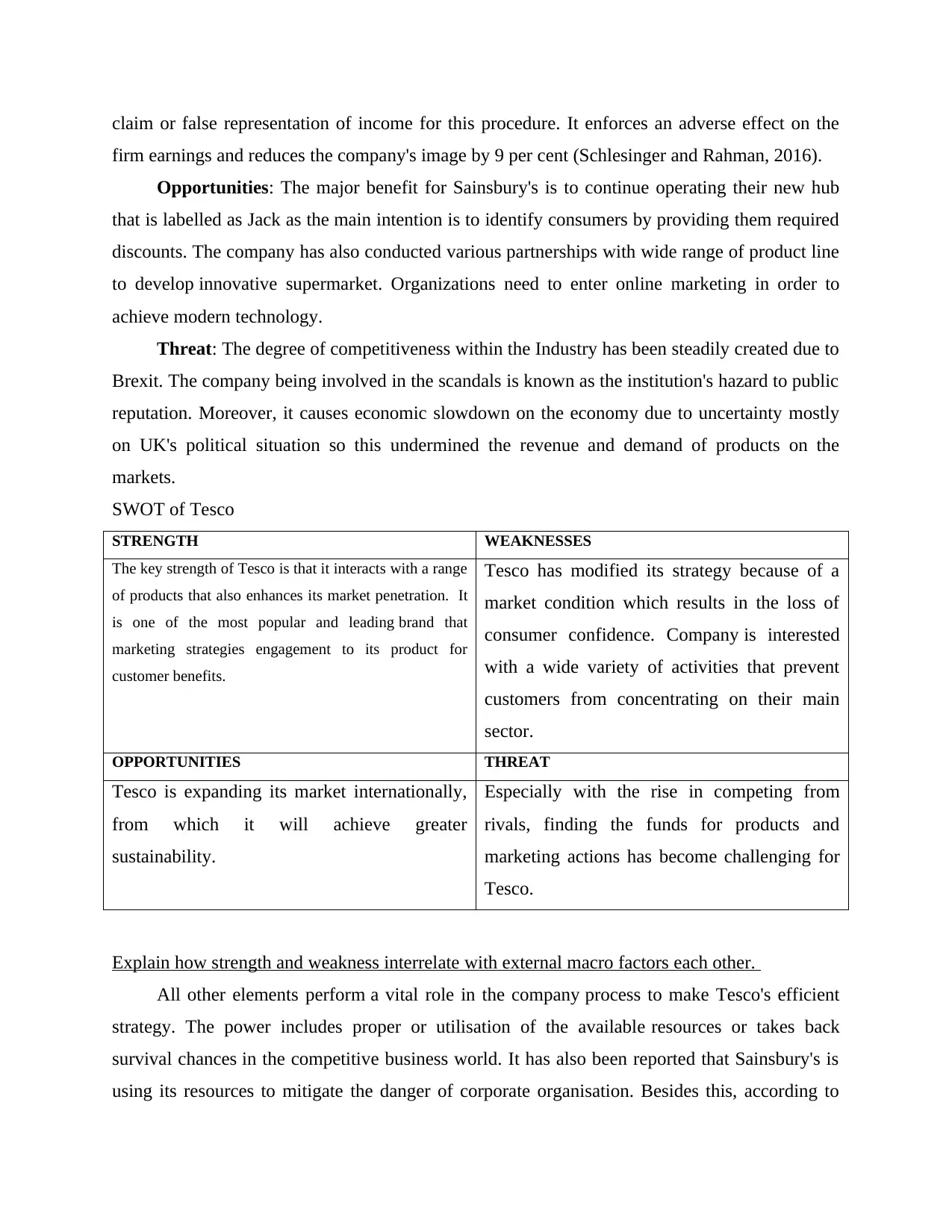
claim or false representation of income for this procedure. It enforces an adverse effect on the
firm earnings and reduces the company's image by 9 per cent (Schlesinger and Rahman, 2016).
Opportunities: The major benefit for Sainsbury's is to continue operating their new hub
that is labelled as Jack as the main intention is to identify consumers by providing them required
discounts. The company has also conducted various partnerships with wide range of product line
to develop innovative supermarket. Organizations need to enter online marketing in order to
achieve modern technology.
Threat: The degree of competitiveness within the Industry has been steadily created due to
Brexit. The company being involved in the scandals is known as the institution's hazard to public
reputation. Moreover, it causes economic slowdown on the economy due to uncertainty mostly
on UK's political situation so this undermined the revenue and demand of products on the
markets.
SWOT of Tesco
STRENGTH WEAKNESSES
The key strength of Tesco is that it interacts with a range
of products that also enhances its market penetration. It
is one of the most popular and leading brand that
marketing strategies engagement to its product for
customer benefits.
Tesco has modified its strategy because of a
market condition which results in the loss of
consumer confidence. Company is interested
with a wide variety of activities that prevent
customers from concentrating on their main
sector.
OPPORTUNITIES THREAT
Tesco is expanding its market internationally,
from which it will achieve greater
sustainability.
Especially with the rise in competing from
rivals, finding the funds for products and
marketing actions has become challenging for
Tesco.
Explain how strength and weakness interrelate with external macro factors each other.
All other elements perform a vital role in the company process to make Tesco's efficient
strategy. The power includes proper or utilisation of the available resources or takes back
survival chances in the competitive business world. It has also been reported that Sainsbury's is
using its resources to mitigate the danger of corporate organisation. Besides this, according to
firm earnings and reduces the company's image by 9 per cent (Schlesinger and Rahman, 2016).
Opportunities: The major benefit for Sainsbury's is to continue operating their new hub
that is labelled as Jack as the main intention is to identify consumers by providing them required
discounts. The company has also conducted various partnerships with wide range of product line
to develop innovative supermarket. Organizations need to enter online marketing in order to
achieve modern technology.
Threat: The degree of competitiveness within the Industry has been steadily created due to
Brexit. The company being involved in the scandals is known as the institution's hazard to public
reputation. Moreover, it causes economic slowdown on the economy due to uncertainty mostly
on UK's political situation so this undermined the revenue and demand of products on the
markets.
SWOT of Tesco
STRENGTH WEAKNESSES
The key strength of Tesco is that it interacts with a range
of products that also enhances its market penetration. It
is one of the most popular and leading brand that
marketing strategies engagement to its product for
customer benefits.
Tesco has modified its strategy because of a
market condition which results in the loss of
consumer confidence. Company is interested
with a wide variety of activities that prevent
customers from concentrating on their main
sector.
OPPORTUNITIES THREAT
Tesco is expanding its market internationally,
from which it will achieve greater
sustainability.
Especially with the rise in competing from
rivals, finding the funds for products and
marketing actions has become challenging for
Tesco.
Explain how strength and weakness interrelate with external macro factors each other.
All other elements perform a vital role in the company process to make Tesco's efficient
strategy. The power includes proper or utilisation of the available resources or takes back
survival chances in the competitive business world. It has also been reported that Sainsbury's is
using its resources to mitigate the danger of corporate organisation. Besides this, according to
⊘ This is a preview!⊘
Do you want full access?
Subscribe today to unlock all pages.

Trusted by 1+ million students worldwide
1 out of 15
Related Documents
Your All-in-One AI-Powered Toolkit for Academic Success.
+13062052269
info@desklib.com
Available 24*7 on WhatsApp / Email
![[object Object]](/_next/static/media/star-bottom.7253800d.svg)
Unlock your academic potential
Copyright © 2020–2025 A2Z Services. All Rights Reserved. Developed and managed by ZUCOL.





